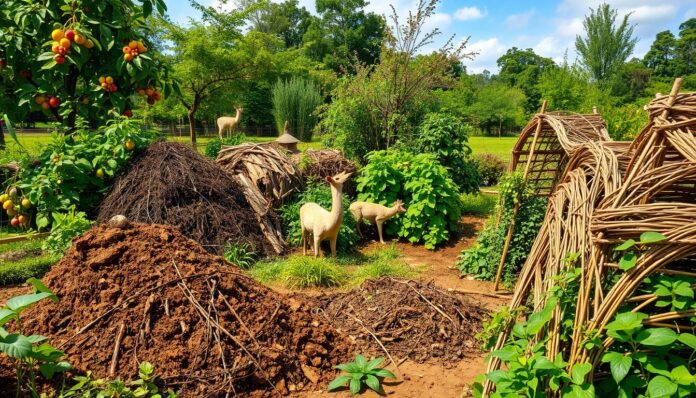Imagine if we could change how we handle waste in permaculture. This change could make our system more sustainable and regenerative. Industrial agriculture wastes about 50% of food due to inefficiencies in production, storage, and transport. This shows we need better ways to manage waste in permaculture.
Recycling and managing waste streams in permaculture are key. They help reduce waste and encourage sustainable practices.
Key Takeaways
- Managing waste streams in permaculture can cut waste by up to 50% with efficient practices and recycling.
- Community composting can cut household waste by up to 30%. It improves soil health and reduces landfill waste through effective waste management.
- Sharing extra food with the community can cut food waste by about 20%. It builds a culture of sharing and sustainability in permaculture.
- Using food scraps from restaurants and events can boost home garden compost by up to 25%. It enriches soil and improves plant nutrition through recycling and waste management.
- The Zero Waste concept can cut household waste by 50% with practices like composting and water-wise gardening. It promotes sustainable waste management and permaculture.
- Permaculture can use less water by techniques like buried ollas. This reduces environmental impact and promotes sustainable waste management.
- Effective waste management and recycling in permaculture can make our system more sustainable. It reduces waste and encourages eco-friendly practices.
Understanding Permaculture Waste Streams
Permaculture design focuses on sustainable waste disposal and using resources wisely. It teaches us to see waste as a valuable resource, not something to throw away. The goal is to create no waste, as stated in Holmgren’s Permaculture: Principles and Pathways Beyond Sustainability.
Permaculture views waste as a resource, not just something to get rid of. This thinking is key for sustainable waste disposal. By using organic waste permaculture methods, we can lessen our impact on the environment. Strategies like composting, recycling, and repurposing help us live more sustainably.
Definition of Waste Streams in Permaculture
In permaculture, waste streams are materials not being used well. This includes organic waste like food scraps and yard trimmings, and non-organic items like plastics and metals. Finding ways to use these waste streams is part of effective permaculture design waste management.
Importance of Waste Management in Permaculture
Waste management is vital in permaculture. It helps save resources, cuts down pollution, and boosts biodiversity. By practicing sustainable waste disposal, we help the environment and work towards a greener future. Using organic waste permaculture in our daily lives can make a big difference, locally and globally.
| Waste Type | Management Strategy |
|---|---|
| Organic Waste | Composting, Vermicomposting |
| Inorganic Waste | Recycling, Repurposing |
Types of Waste Streams in Permaculture
Permaculture focuses on managing different waste streams. This includes organic, inorganic, and e-waste. By using effective waste solutions, we can reduce waste and make our environment more sustainable. A good waste system in permaculture helps use resources better and waste less.
Organic Waste
Organic waste, like food scraps and yard trimmings, can be composted. This turns it into fertilizer. By composting, we cut down on landfill waste and make soil better for plants. This way, we help the environment and support a sustainable food system.
Inorganic Waste
Inorganic waste, like plastics and metals, can be recycled. Recycling and upcycling are key to reducing landfill waste. A well-planned waste system in permaculture encourages sustainable use of resources.
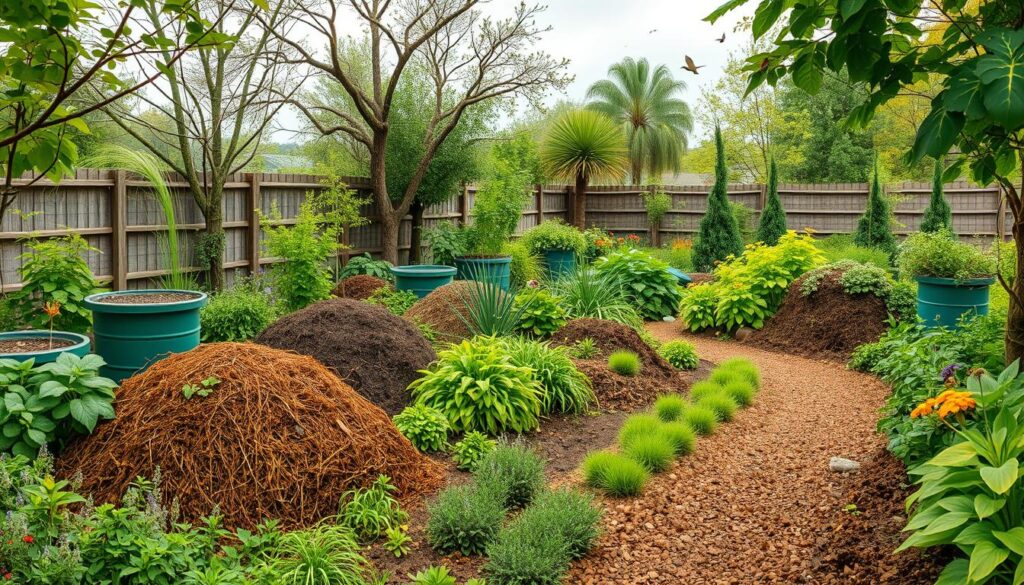
E-waste and Its Management
E-waste, including old electronics and batteries, needs special care. Recycling programs for e-waste help lessen its environmental harm. A permaculture waste system can handle e-waste and other waste, making waste management more eco-friendly.
| Type of Waste | Management Strategy |
|---|---|
| Organic Waste | Composting and fertilization |
| Inorganic Waste | Recycling and upcycling |
| E-waste | E-waste recycling programs |
The Role of Composting in Permaculture
Composting is key in permaculture. It helps manage waste and makes soil rich in nutrients. Organic materials like food scraps and yard waste are turned into a valuable fertilizer for plants. This method is vital for a healthy, sustainable ecosystem.
Composting in permaculture has many benefits. It reduces waste, makes natural fertilizer, and boosts soil health. It also fights climate change by cutting down methane from landfills. The U.S. Environmental Protection Agency (EPA) says food and garden waste make up about 28% of U.S. waste.
Benefits of Composting
- Reduces waste and minimizes landfill waste
- Makes natural fertilizer for plant growth
- Improves soil health with organic matter and nutrients
- Reduces methane, helping fight climate change
Methods of Composting
Permaculture offers several composting methods. Hot composting uses lots of nitrogen-rich materials like food scraps. Cold composting adds more carbon-rich materials like leaves and twigs. Vermicomposting uses worms to break down materials.
| Composting Method | Description |
|---|---|
| Hot Composting | Adding high amounts of nitrogen-rich materials to the compost pile |
| Cold Composting | Adding more carbon-rich materials to the compost pile |
| Vermicomposting | Using worms to break down organic materials |
Using permaculture composting helps reduce environmental impact. It manages waste streams well, cutting down landfill waste. This promotes a healthier environment.
Utilizing Organic Waste in Permaculture
Organic waste permaculture is key to living sustainably. It aims to use resources wisely, reducing waste. By using permaculture design waste management, we can lessen our impact on the environment. For example, soil organic matter is crucial for soil health, which supports plant growth.
Recycling kitchen scraps and food waste is vital in organic waste permaculture. Composting reduces landfill waste and makes soil rich in nutrients. Yard waste and mulching keep soil moist, control weeds, and regulate temperature.
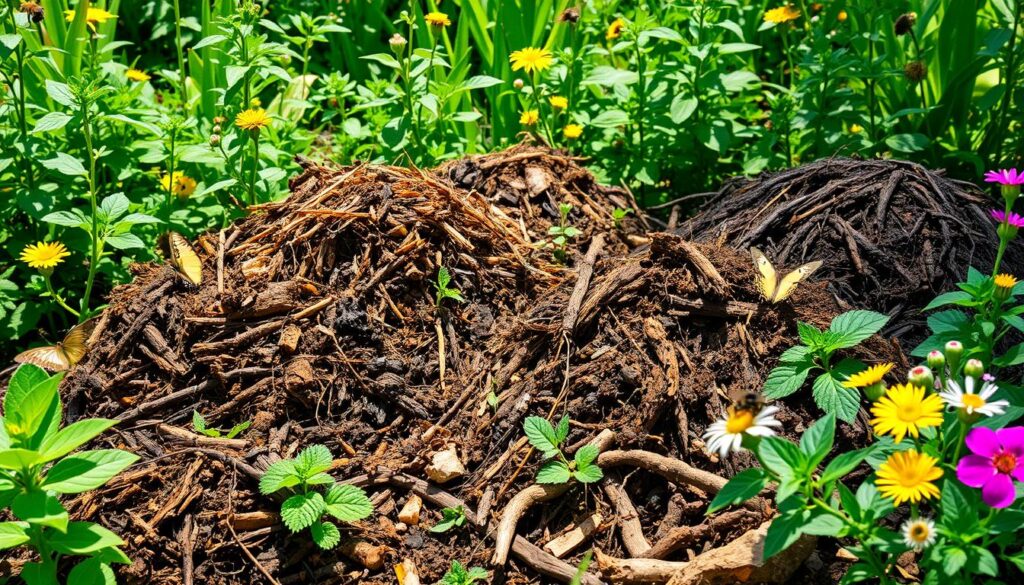
- Composting food scraps and yard waste
- Using mulch to retain soil moisture and suppress weeds
- Implementing permaculture design principles to minimize waste
By adopting these methods, we help create a sustainable future. Organic waste permaculture is essential for keeping ecosystems balanced. As permaculture practitioners say, seeing waste as a resource is vital for a regenerative world.
Managing Animal Waste in Permaculture Systems
Animal waste is a valuable resource in permaculture. It acts as a nutrient-rich fertilizer for gardens and fields. Proper management of this waste is key to keeping soil healthy and preventing pollution. It also supports sustainable practices.
When designing for livestock waste, it’s important to provide enough space for animals. They need room to move and access to food and water. A well-designed animal shelter can help manage waste more efficiently. For instance, a deep litter system for pigs can make composting easier and more effective.
Composting Animal Manure
Composting animal manure is a great way to manage waste. It turns waste into a valuable resource for gardens. The composting process needs a carbon to nitrogen ratio of about 30:1. It also needs to reach a temperature of 135-160°F (57-71°C) to kill harmful pathogens.
Integrating Animal Waste into Soil Health
Adding animal waste to soil is crucial for keeping it fertile. Composting animal waste creates nutrient-rich compost. This compost slowly releases nutrients, improving soil moisture and suppressing weeds.
Using compost as a top dressing can also enhance soil structure. It promotes healthy plant growth. This supports waste management and recycling in permaculture.
- Proper composting can eliminate harmful pathogens in animal waste
- Recommended carbon to nitrogen ratio in composting is approximately 30:1
- Ideal temperature range for compost pile to effectively kill harmful pathogens is 135-160°F (57-71°C)
By using effective waste management and recycling, we can reduce waste. This promotes sustainable practices and keeps soils healthy. It supports permaculture waste streams and a more sustainable future.
Recycling Inorganic Materials
Recycling inorganic materials is key in permaculture waste solutions. It cuts down on landfill waste and saves natural resources. In a permaculture system, recycling can be done by upcycling and repurposing items. For example, old pallets can become planters or garden benches. Plastic bottles can be turned into self-watering planters for plants.
Composting organic waste is also important in permaculture. But recycling inorganic waste needs a different method. By finding and reusing inorganic waste, people can lessen their environmental impact. Community recycling programs offer help and support for those wanting to be more eco-friendly.
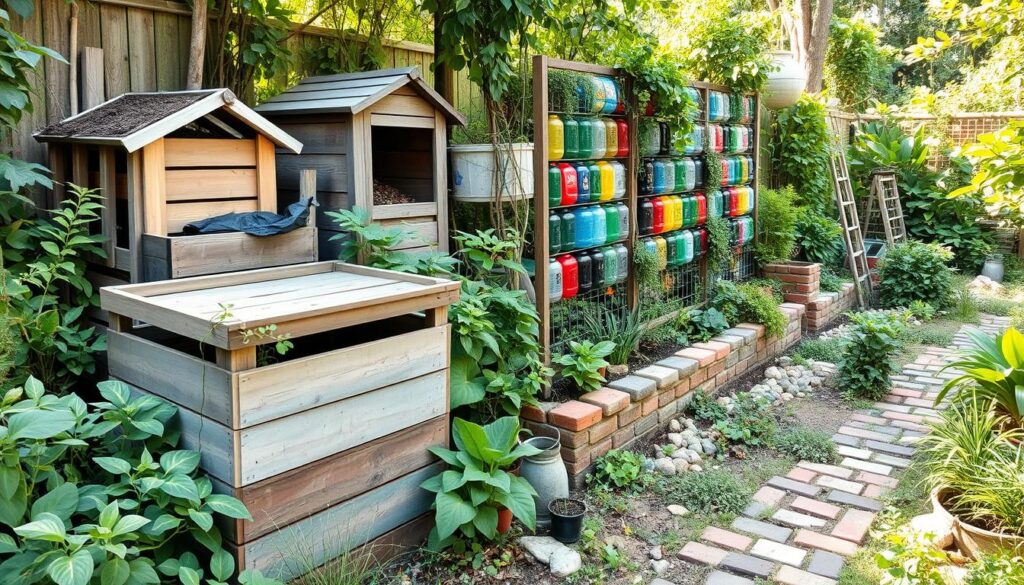
- Repurposing old furniture or household items into planters or garden features
- Using recycled materials to build garden paths or borders
- Participating in community recycling programs or initiatives
By using these strategies, people can help make the permaculture waste system more sustainable. This reduces their environmental impact.
E-waste in Permaculture
Electronic waste, or e-waste, is a big problem in permaculture. It adds to the growing waste management issue. The world is facing a huge waste problem, with millions of tonnes of e-waste dumped every year.
In 2019, only 17.4% of global e-waste was recycled. This shows we need better ways to dispose of it. We need strategies for managing waste in permaculture.
Reducing waste in permaculture is key. E-waste can harm the environment and our health if not handled right. We can lower waste by using sustainable practices and working with recycling firms.
This approach helps reduce waste and supports a circular economy. It’s a step towards a more sustainable future.
Understanding E-waste Challenges
The amount of e-waste could double by 2050 if we don’t act. Companies like Apple are starting to tackle this problem. They have programs like the Daisy recycling robot, which can process 1.2 million devices a year.
Responsible Disposal Methods
Recycling and proper disposal of hazardous materials are key. Working with recycling firms ensures e-waste is handled right. Together, we can lessen the environmental harm of e-waste and work towards a greener future.
Water Management and Waste Streams
Effective water management is key in permaculture. It affects the health and productivity of the ecosystem. By using smart water management, permaculture experts can cut down waste and support sustainable practices. This is vital for permaculture waste streams, as water is crucial for nutrient and waste cycling.
In waste management permaculture, water management means using methods like greywater recycling, rainwater harvesting, and wetlands for wastewater treatment. These methods save water and lessen waste from permaculture systems. For example, greywater recycling can water plants, cutting down on fresh water use and permaculture recycling needs.
Greywater Recycling Approaches
Greywater recycling is a big part of water management in permaculture. It uses wastewater from sinks, showers, and washing machines. This way, permaculture experts can lessen their water use and waste. It works well with permaculture recycling like composting and mulching.
Rainwater Harvesting Systems
Rainwater harvesting is also key for water management in permaculture. It collects and stores rainwater, reducing the need for municipal water. This method is great when paired with waste management permaculture like greywater recycling and composting.
Reducing Waste Streams through Design
By using permaculture design waste methods, people can greatly lessen their impact on the environment. This approach includes strategies like composting and recycling to cut down on waste. It aims to turn waste into something valuable, creating closed-loop systems.
Designing for zero waste is key in permaculture. It means rethinking how we use and make things, and reducing our use of non-renewable resources. Creating systems where materials keep being used is also vital. This way, we use resources better and make less waste.
Some good ways to tackle waste in permaculture include:
- Composting food waste to make rich soil
- Recycling things like paper, plastic, and glass
- Using rainwater harvesting systems to save water
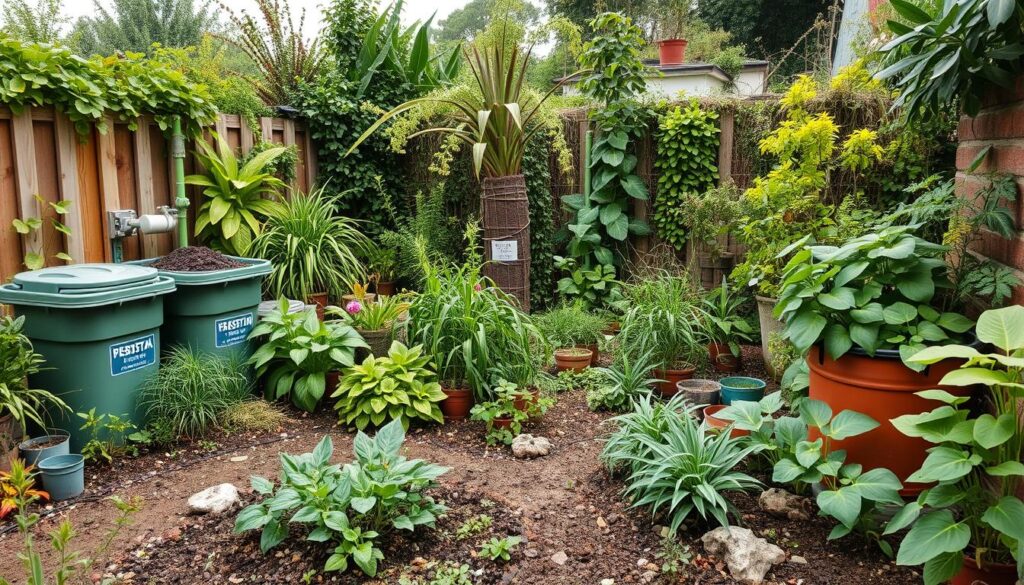
By using these methods, people can cut down their waste a lot. This helps make the future more sustainable. It’s good for the planet and for local communities too, as it saves money and resources.
Education and Community Involvement
Education is key in teaching people about permaculture waste streams and how to manage them. Workshops and partnerships with local groups help spread the word. This way, we can all learn to live more sustainably.
Engaging the community is vital for success in permaculture. We can use fun methods like ball-tossing to learn about permaculture. This makes it easier for everyone to talk about and remember these important principles.
Working together is crucial for managing waste in our communities. It helps us create better recycling systems and reduce waste. This teamwork also fights for fairness and equality, which are core to permaculture.
The table below shows why community involvement is so important in permaculture:
| Aspect | Importance |
|---|---|
| Education | Promotes awareness about permaculture waste streams and waste management permaculture |
| Community Involvement | Essential for successful permaculture waste management and promoting equity |
| Permaculture Recycling | Reduces permaculture waste streams and promotes eco-friendly habits |
By teaming up and using these methods, we can make our communities better. We can reduce waste and promote recycling and sustainable living.
Innovations in Permaculture Waste Management
Permaculture waste solutions are getting better to meet our need for green waste management. A new way is to use a permaculture waste system that cuts down, reuses, and recycles waste. This is done through permaculture composting, which makes organic waste into rich soil.
Reducing waste is a big part of permaculture waste management. We can do this by growing food locally and recycling or reusing most waste at home. For instance, composting food waste makes great fertilizer, cutting down on synthetic fertilizers. Also, switching from plastic to paper and cardboard packaging helps with recycling and composting.
Technological Advances in Waste Processing
New tech is coming out to make waste processing better and cheaper. These include advanced composting like anaerobic digestion and waste-to-energy systems. With these, permaculture folks can make waste management systems more efficient and green.
Integrating Permaculture with Urban Development
Permaculture can help make cities better and greener. This means designing parks and gardens and using permaculture waste systems. By mixing permaculture with city planning, cities can lessen their harm to the environment and make life better for people living there.
Exploring New Materials for Sustainable Practices
Scientists are looking into new stuff and tech for sustainable permaculture. They’re working on biodegradable packaging and making products from recycled waste. These innovations help permaculture folks lessen their environmental impact and build greener systems.
Regulatory Framework Influencing Waste Management
Effective waste management in permaculture systems is heavily influenced by the regulatory framework governing waste streams. Understanding local permaculture regulations is crucial for implementing efficient waste management practices. Permaculture waste streams can be significantly reduced by adopting sustainable methods such as composting and recycling, which are integral to waste management permaculture principles.
Navigating environmental policies and legislation is essential for promoting permaculture recycling and minimizing waste. By supporting local economies and reducing reliance on non-renewable resources, individuals can contribute to a more sustainable future. Buying local products can cut back on wasteful packaging, lower carbon footprints, and support local economies.
Key strategies for reducing waste and promoting sustainable practices include:
- Implementing closed-loop systems to minimize waste generation
- Adopting efficient water management techniques, such as rainwater harvesting
- Encouraging community involvement in sustainable practices
By understanding and adhering to local regulations and environmental policies, individuals can make a positive impact on permaculture waste streams and contribute to a more sustainable future. The integration of waste management permaculture principles and permaculture recycling methods can significantly reduce waste and promote eco-friendly practices.
Case Studies: Successful Waste Management
Effective waste management is key in permaculture. Many case studies show how permaculture waste solutions work well. They often use a permaculture waste system with permaculture composting methods.
San José, California, is a great example. They have a Zero Waste Strategic Plan. It aims to collect food waste efficiently. This waste is then used for permaculture composting and making biogas for energy.
Lessons Learned from Various Communities
Communities worldwide have found ways to manage waste well. In The Hague, people and the city work together. They improve organic waste management through actions and citizen involvement.
Adaptations for Different Climate Zones
Waste management needs to adapt to different climates. In Malawi, permaculture farming shows great results. Farmers have better food security, more diverse diets, and higher yields than conventional farmers.
This highlights the need for climate-specific permaculture waste solutions. It shows how important it is to tailor a permaculture waste system to each area.
Challenges in Managing Waste Streams
Reducing waste is key to sustainable living. It helps lessen the harm we do to the environment. But, many don’t know how important it is to manage waste well.
Managing waste streams in permaculture means using strategies like composting and recycling. Food scraps and yard waste can make great soil. Waste management permaculture looks at the whole waste stream, aiming to reduce, reuse, and recycle.
Challenges include not having enough space and not knowing enough. But, we can find creative solutions. Like vertical gardening and using old materials. We can also learn more through community programs.
New ways to manage waste are coming, like vermicomposting and ecobricks. There’s also a push to cut down on single-use plastics. Sustainable living and minimalism are becoming more popular.
| Waste Management Strategy | Benefits |
|---|---|
| Composting | Reduces waste, creates nutrient-rich soil |
| Recycling | Conserves resources, reduces landfill waste |
| Repurposing | Reduces waste, promotes creativity and sustainability |
Measuring Success in Waste Management
Effective waste management in permaculture means keeping track of how well waste reduction works. This is done by watching key signs, like how much waste is made, recycled, and turned into compost. Permaculture practice stresses the need to always check and get better at managing waste.
Some important signs for permaculture waste management are:
- How much organic waste is turned into compost
- How much inorganic waste is recycled
- How much waste is cut down through recycling and composting
Tools for tracking waste reduction include waste audits, software for tracking waste, and surveys of the community. By checking and reviewing waste management plans often, permaculture folks can spot where to get better. They can then make choices based on facts to improve their waste reduction.
Permaculture waste streams can be managed well by aiming for zero waste. This means making less waste and using more recycling and composting. This goal is reached through waste management permaculture methods, like using less, reusing things, and recycling organic waste.
By using a permaculture way to handle waste, people and groups can lessen their harm to the environment. They can also save natural resources and support living in a sustainable way.
Save your seeds. By growing, saving and exchanging seeds we can help stop the loss of food biodiversity and build local resilience.
| Waste Management Strategy | Benefits |
|---|---|
| Composting | Reduces organic waste, produces nutrient-rich soil |
| Recycling | Conserves natural resources, reduces landfill waste |
| Permaculture recycling | Minimizes waste generation, promotes sustainable living |
Conclusion: Moving Towards Sustainable Waste Management in Permaculture
Looking at permaculture, we see that managing waste is key. The idea of “Produce No Waste” helps create systems that work like nature. By composting and recycling, we turn waste into something useful for our soil and plants.
Recap of Key Points
This article covered different types of waste in permaculture and how to handle them. We talked about composting, using old materials again, and managing water. These steps help us see waste as something valuable, not just a problem.
Encouragement for Community Action
Managing waste in permaculture is a team effort. We urge everyone to share what they know and join local projects. Together, we can make systems that are good for the planet and last for the future.
Vision for the Future of Permaculture Waste Management
We dream of a future where waste is seen as a resource, not a problem. With new tech and teamwork, we can make permaculture communities that are circular and regenerative. They will show the world how to live sustainably.

